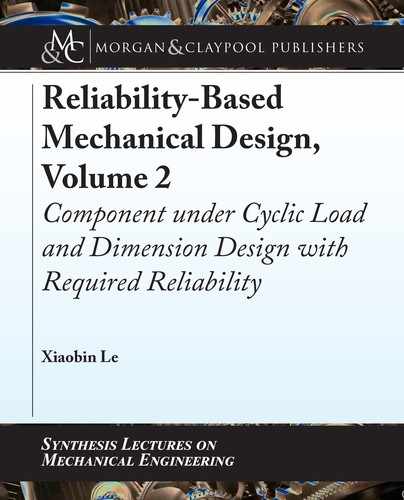
9
C H A P T E R 2
Reliability of a Component
under Cyclic Load
2.1 INTRODUCTION
Metal components under repeated loadings, that is, cyclic load, can fracture even though the
component’s maximum nominal stress is far less than ultimate material strength or yield strength.
is type of failure is fatigue failure. In industries, more than 90% of metal component failure
is due to fatigue failure.
A fatigue issue with the number of cycles at failure between 1 and 10
3
is generally classified
as low-cycle fatigue. When the number of cycles at failure is more than 10
3
, it is high-cycle fa-
tigue. is chapter will only focus on high-cycle fatigue, which is the typical case for mechanical
component design in industries.
e component design, that is, determination of component geometric dimension under
cyclic loading with the specified reliability will be discussed in Chapter 3. is chapter will show
and explain how to calculate the reliability of a component under cyclic loading. e reliability
calculation of a component with an infinite life will be discussed in Section 2.7. Two different
probabilistic fatigue theories will be used to conduct the reliability calculation of a component
with a finite fatigue life. One theory is the P-S-N curves approach, which will be discussed
and explained in Section 2.8. Another theory is the probabilistic fatigue damage theory, which
includes fatigue strength index K and the fatigue damage index D. is probabilistic fatigue
damage theory can be called as the K-D model, which will be discussed and explained in Sec-
tion 2.9.
is chapter will present and discuss different methods to determine the reliability of a
component under any cyclic load with plenty of examples.
2.2 FATIGUE DAMAGE MECHANISM
Fatigue phenomena were first discovered and studied during the 19th century with the arrival of
machines and freight vehicles during the industrial revolution [1]. Fatigue is defined as “failure
under a repeated or varying loading, which never reaches a level sufficient to cause failure in a
single application.”
Fatigue failure of a metal component under cyclic loading is a complicated phenomenon,
and only partially understood [2]. However, we have a fundamental understanding of fatigue
10 2. RELIABILITY OF A COMPONENT UNDER CYCLIC LOAD
failure or fatigue damage. Fatigue damage is the weakening of a metal material due to a gradually
crack propagation of inherent existing microscopic cracks or defect inside or on the surface of
the metal component under repeated cyclic loading. Without a crack inside or on the surface of
a metal component, there is no fatigue. If the magnitude of cyclic loading is not big enough to
generate a crack propagation, there will be no fatigue.
e fatigue damage mechanism can be typically described by the following four stages.
Let use a microscopic crack on the surface to explain and demonstrate these. Figure 2.1 shows a
magnified microscopic crack on the surface of a component under a fully reversed cyclic bending
moment. In this example, let us assume that the nominal normal stress due to the bending stress
is 20 ksi, and the material yield strength is 60 ksi.
1. Crack initiation. ere are always lots of randomly distributed defects inside a component
such as voids and dislocations and on the surface of a component such as manufacturing
scratches [3]. A fatigue crack will typically initiate at a microscopic crack or defect inside
or on the surface of a component. As shown in Figure 2.1a, the bending moment tries
to open the microscopic crack “A”, which will have very high stress because of the sharp
tip of the microscopic crack “A”. Let us assume that the stress concentration factor in
this situation is 3.5. So, the maximum stress at the tip of the microscopic crack “A” could
be 3:5 20 D 70 ksi and will be larger than the material yield strength. e material at
the tip of the crack “A” will start yielding and has some plastic deformation, as shown in
Figure 2.1b. When the material at the tip is yielding, the sharp tip of the crack “A” will
become a dull tip, and the stress concentration factor decreases. Let assume that the stress
concentration factor becomes 2.5. Now the maximum stress at the dull tip of the crack “A”
is 2:5 20 D 50 ksi. It is less than the material yield strength. erefore, the yielding at
the tip of the crack “A” will stop. If external loading is not a cyclic loading, the effect of
the microscopic crack “A” on the component is negligible and can be ignored because the
plastic deformation at the tip of the crack “A” is in microscopic level.
2. Crack propagation. When the component is under a fully reversed cyclic loading, the
reversed bending moment now tries to close the microscopic crack “A”, as shown in Fig-
ure 2.1c. It is well known that if the dull tip of the microscopic crack “A” undergoes “strain
hardening” due to the yielding [3], the material around the dull tip area will be brittle. Af-
ter one time or a few times of such “open” and “close” actions, a new microscopic crack
“B” will be generated beneath the crack “A”. is result is a crack propagation, as shown
in Figure 2.1c. When the component is under a fully reversed cyclic loading, the micro-
scopic crack “B” will be opened again as shown in Figure 2.1d, which is the same situation
as shown in Figure 2.1a. In this stage, the crack could continue to grow as a result of
continuously applied cyclic loading.
3. Fracture due to static loading. Eventually, a crack will reach a critical size and the effective
cross-sectional area of the component is so reduced that the actual stress on the effective
..................Content has been hidden....................
You can't read the all page of ebook, please click here login for view all page.
